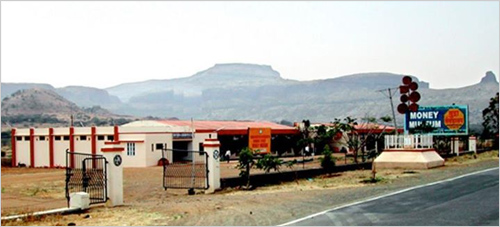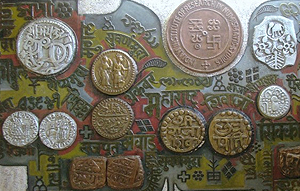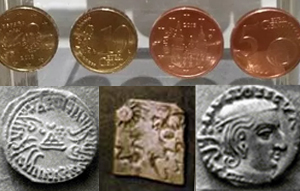
Is a research Institute on numismatics, particularly on Indian numismaticstudies. They have trained researchers who have specialized on differentnumismatic periods, such as ancient, early medieval, medieval and latemedieval. They offer services (free of cost) to any enquiry, made throughthe mail or otherwise, on academic aspect of any coin or coin series foundin India. They also have a well equipped library having a good collectionof numismatic and allied books. The library also houses photo cardexesof coins (arranged series-wise) numbering approximately 1,50,000. Any scholaror lay individual is most welcome to visit them and take advantage of theirfacilities. They have a Scholars’ Residence with all modern amenities withintheir campus, which is open (at a nominal charge) to anybody desirous ofdoing research / study on coins at their Institute.
 Their Institute also conducts an Annual 15 Day Training Course calledPractical Guide to the Fundamentals of Indian Numismatics which is opento any individual retaining an interest on coins. Besides, they also conductshort Learners Courses of five days duration.
Their Institute also conducts an Annual 15 Day Training Course calledPractical Guide to the Fundamentals of Indian Numismatics which is opento any individual retaining an interest on coins. Besides, they also conductshort Learners Courses of five days duration.
They have also got their separate Publication Division called IIRNSPublications which publishes their Annual Research Journal Numismatic Digestand other monographs from time to time.
Their Institute publishes a quarterly newsletter called IIRNS Newslinewhich is sent free of charge. Please note that there is no membership offered by them.

Indian Institute of Research in Numismatic Studies was founded in 1980.It is an outcome of the recognition of the long – felt need for a researchcentre devoted to the furthering of Indian Numismatic Studies, especiallyas it relates to history, archaeology, economics and art. The manifestationof this need was brought about when Dr. Parmeshwari Lal Gupta, a numismatistof global recognition and Shri K. K. Maheshwari, an industrialist and anumismatist in his own right, came together to discuss the feasibilityof an Institution which could act as a veritable storehouse of informationon the study of Indian coins, where students could be trained in numismaticstudies and guided in the numismatic research and which as a corollary,could serve the interests of a long neglected discipline. The Institutewas thus born in 1980, being registered as a Trust under the Bombay PublicTrust Act, 1950 (Registration No E-7625 Bombay). Since then, the Institutehas earned international recognition for the works done within a very shortspan of time.
In 1984, the Institute shifted to its present location at the scenicsite of Anjaneri, about 19.5 km. from Nashik city, on Nashik-Trimbakeshwarroad. It has a campus spread over 5.5 acres (approx.) , with the ResearchCentre building, Guest House and staff quarters.
The Institute’s Board of Management consists of the Board of Trustees,Board of Advisors and the Governing Body.
Numismatics means the study of coins. But it is not merely the study ofthe physical features of coins. It is the study of coins as an historicalobject and a source for history, as coins are one of the most valuabletools for reconstructing our history. A serious student of Indian historymay well be aware of this fact. But those who may not have much idea aboutthe sources which help us in knowing our history, may well be amazed toknow that but for coins, we would be almost completely in the dark aboutmany periods of our history.
Coins also provide important chronological information in the archaeologicalexcavations. Besides, they can also provide valuable information abouteconomy – trade, monetary policy, currency system and so on and alsoabout art and culture.
Considering the vital importance of coins as a source for our history,it is really surprising how often Numismatics has been seen as a tiny elementof Indian historical and archaeological studies. It cannot, however, bedenied that the potential of Indian Numismatics needs to be fully realisedto further enrich our historical and archaeological studies. It was withthis realization and to preserve valuable information about our historicaland cultural heritage, that the Institute started functioning with thefollowing aims and objectives.
Photographic Archives
coin3One of the important aimsof the Institute is to make available easily to the students of numismaticsthe research data, the access to which is otherwise difficult. Towardsthis end is directed its photographic archives, which it maintains as along-term project.
The Photographic Archives contains photographs of coins from differentcollections – Institutional and private- in the form of a cardex mountedwith a coin photograph and with the relevant information. Under this project,the data in the form of photographs of coins from various collections arebeing continuously added to the Archives and also being updated.
Projects
The Institute undertakes independent research projects in the fieldof numismatic studies. The selection of the research programmes is guidedby the need for investigations into the problem areas of numismatic studiesand also by the need for providing a framework for the better utilizationof numismatic data and for developing and preparing teaching aids. Theresult of some such investigations completed earlier have been published.Some research projects are also undertaken in collaboration with otherInstitutions.
In formulating its educational and training programme, the Instituteconsiders several categories of students and researchers, the problemsfaced by them and the help the Institute can provide to them.
These include –
For these different categories of students, the Institute planned to conducttwo types of courses – one, a short term course and the other, a long termcourse.
Since 1987, the Institute has been conducting a short training course of15 days duration called Workshop on Practical Guide to the Fundamentalsof Indian Numismatics. It is conducted once a year, usually in the monthsof October – November. The emphasis of this course is on the practicalaspects and teaching of the basic methods required for the study of coins.Participants of the Workshop are provided with the coins belonging to theperiod and area of their research / interest, which they study, under guidedsupervision and with the help of various aids developed by the Instituteunder six courses:
This training course has been quite well received and is attended bythe personnel of the Department of Archaeology and museums of various states,university and college teachers, research scholars and coin collectors.
For school and college students and other visiting groups, the Institutearranges, on request, talks by its faculty members, and also slide shows.
To impart a general idea about Indian coins to the common people, theInstitute has organized a small museum. The museum offers a panoramic viewof Indian coinage from the earliest period to the modern times with thehelp of coins, moulds, dyes, replicas, photographs, and brief write-ups.Dioramas depicting coin minting and coin manufacturing techniques, likecasting, machine-striking, etc. are also on exhibit.
Apart from the numismatic material, some bronzes, terracottas, copper- hoard objects, paintings and some other historical artefacts are alsodisplayed. The Museum is open to the visitors from Mondays to Saturdays(except holidays) from 9.30 am to 1.00 p.m. and 2 p.m. to 5.30 p.m. Admissionis free.
Apart from the research and educational facilities, the museum throughits photo archives, also offers an easy access to the coin data of manydifferent collections. Further the Institute offers some other excellentfacilities for research and training.
 The Institute library houses a rich collection of books and journals onIndian numismatics. It also contains publications on archaeology, epigraph,history, source books. etc. The Institute’s endeavour is to collect allthe publications appearing on Indian coins and also to enrich the collectionof books on other allied subjects.
The Institute library houses a rich collection of books and journals onIndian numismatics. It also contains publications on archaeology, epigraph,history, source books. etc. The Institute’s endeavour is to collect allthe publications appearing on Indian coins and also to enrich the collectionof books on other allied subjects.
The library subscribes to, and receives, almost all the journals dealingwith Indian numismatics. Efforts are being made to obtain the missing numbersif any,as well as the older journals which have gone out of print. Thelibrary also subscribes to many periodicals and journals on foreign numismatics,history, archaeology and epigraphy.
The Offprint Section of the library is well-classified and indexedand includes articles on Indian numismatics published in numismatic aswell as non-numismatic journals / volumes. The emphasis of this sectionis to procure particularly those articles which are published in foreignor Indian journals not easily available in the libraries and also thosewhich appear in felicitation, commemoration, seminar volumes etc.
In the Document Archives Section of the library, letters andprivate papers of eminent scholars are maintained as archival documents.
Clippings of news related to numismatics appearing in newspapersand magazines are kept classified in the News Clipping Section of the library.
Bibliography Section
The Institute maintains a Bibliography Section. Under this section,records of articles appearing on Indian coins are maintained with a briefsummary and proper classification.
This is very useful for the research scholars as it saves their timeand money, which would otherwise have been spent in looking for referencesin various journals and volumes in different libraries. The bibliographyis made available on payment of a prescribed fee.
Photo Supply
On payment of prescribed charges, the Institute supplies photographsof coins from its Negative Archives for being utilized in theses, dissertations,publications or as study material.
Photo Copy supply
The Institute has its own photo – copier, and provides photo copiesof the required articles. etc. on request, and on payment of nominal charges.
Collection of coins and other research materials
For conducting educational and training courses and for research purposes,the Institute maintains its own collection of coins, coin – hoards, coin- dyes, moulds, etc. Besides, the Institute’s collection includes copperplate inscriptions, Hundi papers, stamp papers, paintings, bronzes, palm-leafmanuscripts, a very good collection of copper hoard objects and some otherhistorical antiquities. Any gift of these objects to the Institute by anyindividual or Institution is welcome.
The Institute has within its campus, a lovely guest house providing accommodationfor eighteen persons at a time, in rooms fully furnished, with attachedbath – rooms, and mess facilities.
The Institute has its own computer setup, and efforts are being made forthe computerization of the research material so as to facilitate easy handlingof research data. Towards this purpose, the Institute has got its own software,called “”Nanaka” , developed to meet its specific needs. The existing hardwareconsists of two separate units, one exclusively for publication and theother for data entry.
Future plans include
P.O. Anjaneri, Dist. Nasik 422 213, Maharashtra, India ![]()
Ph-02594-2235, Fax – 0253-350507